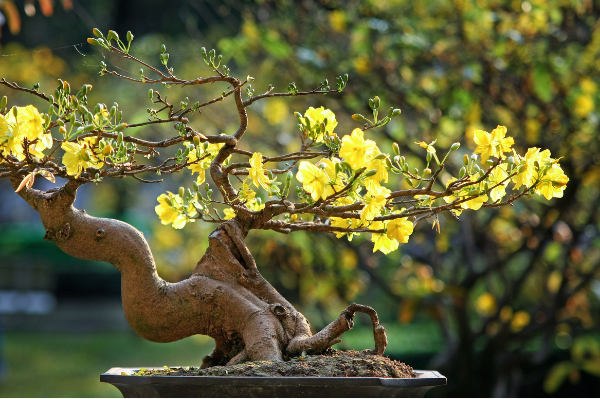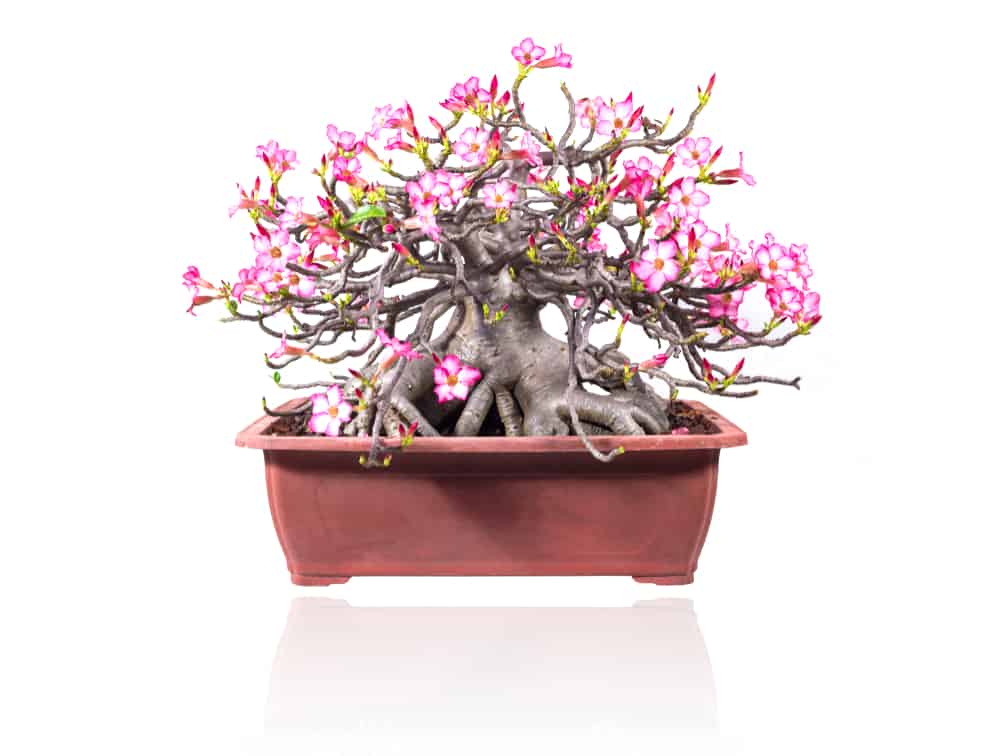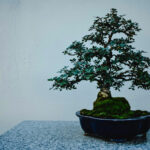HousePlantJoy is supported by our audience. When you purchase through one of our links, we may earn a small affiliate commission. As an Amazon Associate I earn from qualifying purchases. Your cost is not affected.
==================
Flowering Bonsai Trees – How to Care For Them?
Flowering bonsai trees need some special skills to care for them. Why? They are quite popular because of their unique attributes. They often come with stories since take time and demand some skill to create. Also, with their look, they give indoor and outdoor areas some captivating features. Their beauty comes from their colors and shapes. There is something attractive about their leaves, branches, trunk, roots, and blooms. So it’s clear why many homeowners have a selection of these miniature trees inside and in the yard. How to care for flowering bonsai trees is an essential topic to learn if you seriously consider growing them. This flowering bonsai trees care guide will help you start a bonsai project on your own.
In this post, we’ll take a look at eight bonsai flowering plants. We will discuss how they are as plants and some ways to take care of them. Also included are a few tips to make the most of their presence. Hence, stick around and keep reading to find out more about caring for flowering bonsai trees.
Examples Of Flowering Bonsai Trees
Of the thousands of shrub and tree species on the planet, some make the best bonsai flowering plants. It’s often because of their visual appeal, environmental value, and ever-blooming nature. These miniature trees often show bright colors and have strong and healthy parts. Also, they can withstand different weather conditions and provide health benefits. Thus it isn’t surprising why beginners and seasoned plant artists keep them.
Here are 8 examples of the most ornamental flowering bonsai plants to take care of.
Flowering Powder Puff Bonsai Tree
Also called Calliandra Haematocephala, this shrub is quite decorative. Its appearance makes it clear why it belongs in the best flowering bonsai trees. It’s an evergreen plant with divided leaflets and flowers and people make a mini tree out of it. In the fall and winter months, it produces pinkish, reddish, or whitish blooms. The flowers appear as feathery powder puffs and add a natural design to any space. Also, it can thrive indoors, in a sunroom or greenhouse, but may grow better in an ideal outdoor setting. Take note that it requires fair to high humidity and is hardy in zones 9 to 11. Many times, it flourishes better when it has enough warmth and about 6 hours of sunlight exposure. Hence, it’s an example of flowering bonsai plants that can be easy for gardeners.
This powder puff plant has slow growth. Yet, reaching about 6 meters or near 20 feet tall, it’s convenient to accommodate. Because of its evergreen nature, it may need pruning throughout the year. But the regular trimming makes it denser and it then resembles a small tree. Consistent soil moisture keeps it well but there needs to be a drainage hole where it stands. Feeding it with the right liquid fertilizer and wiring gets it growing and shaped too. So it’s sensible why gardeners make it a part of their collection.
Flowering Chinese Fringe Bonsai Tree
Going by the name Loropetalum Chinensis, it’s native to China but is available in other places. It’s easy to find it in Southeast Asia and Japan too. Due to its look, growth, and care requirements, it is among the best flowering bonsai trees. It grows with dark reddish-brown leaves at first that turn green once the plant matures. Producing whitish, off-white, or pinkish flowers in mid-spring, it is a gorgeous plant. Yet it does well in full sun rather than in shaded areas. Hence, it’s more common to see it outdoors and facing the south where it’s often sunny.
Often hardy in USDA zones 7 to 10, it can thrive indoors and take intense cold. For the most part, when inside, gardeners make an effort to keep them in warm places. Due to their adaptiveness, some folks add it to their bonsai flowering plants. It may need weekly watering without rain to keep the soil moist but it’s drought tolerant too. As a bonsai tree, it requires pruning for shaping it and to get rid of any dead wood. In that way, because of how it is, having this plant is also a great choice.
Flowering Chojuho Azalea Bonsai Tree
Since it has colorful blooms and dense leaves plus twigs, people keep it. Because of these features, people see it as one of the most attractive flowering bonsai trees. Yet adding at least one to a garden is great not only because of its decorative appearance. Rather, it’s excellent since it can thrive so well outdoors because of its demand for sunlight. When winter comes, it may be ideal to put it indoors or keep it somewhere warm. An intense cold may make it stressed. But this isn’t an issue at all since a dwarfed version of the tree isn’t that hard to transport. After all, it is usually only 2 to 3 feet high and about 4 feet wide. So having on a patio or somewhere outside is a good idea.
From May to June, star-like flowers that give orangey and reddish hues surface. For this reason, many homeowners make it a part of their flowering bonsai plants. But, after the blooming ends, though, it must undergo immediate pruning. That avoids cutting off the next, fresh buds. Also, it needs daily watering and slow-release fertilizer to flourish. Plus, it would grow well when in sand, clay, or loam. But it is still low-maintenance. Take note that it doesn’t grow fast, will survive outside, and is an evergreen plant. Hence, it appeals to a lot of garden owners.
Flowering Chinzan Azalea Bonsai Tree
Originating from Japan and called Azalea Satsuki ‘Chinzan’, it makes for a great dwarf tree. Due to its star-shaped and pink flowers that develop at the end of spring and early summer days, people love it. Plus, it’s compact with its narrow and dense, green leaves plus height of about 2 feet tall and 4 feet wide. Hence, it’s no wonder why it’s one of the most recognizable flowering bonsai trees.
As a deciduous plant, it is best when placed outside. Azaleas are often outdoor and flowering bonsai plants. It’s not only because its leaves drop off from time to time but also because it does well beneath sunny spots. Still, it needs a bit of monitoring to keep it from getting burnt by intense heat from the sun. Protecting it from freezing temperatures is important too. So placing it right where it can get sun and avoid getting too much cold can help a lot. Still, like the Chojuho, it also needs its flowers pruned for better blooming. So it’s also interesting to add to any garden.
Flowering Desmodium Bonsai Tree
Needing modest watering and fertilizer only, this plant doesn’t demand plenty of attention. Even if it requires plenty of sunlight, it’s one of the flowering bonsai trees with rich features. Because of its pretty, fragrant, and grape-smelling purple flowers, it’s worth having. It looks ornamental and delivers sweet-smelling scents. So, with it, a garden turns beautiful and aromatic altogether.
Also called Desmodium Unifoliatum, it’s a plant that is very resilient or hardy. It tolerates various weather and temperature changes. It needs to be humid but not too moist and can thrive in partial shade too. Yet it cannot withstand being too wet and intense cold since it’s a tropical plant. Thus putting it in a pot that drains well and somewhere that is a bit warm matters. Still, it grows 2 to 4 feet tall as a bonsai and needs constant pruning to keep things that way. Like other miniature trees, it requires trimming to keep it dense and to stop it from getting taller.
Flowering Red Bougainvillea Bonsai Tree
Of the different flowering bonsai trees, this one can be a bit tall. Yet, despite its height, many are recommending it. Why? It’s interesting since it doesn’t have flowers at all. Instead, it has clusters of bracts that look like them. It has red leaflike structures that look like blooms and have true, white flowers within them. Together with the said parts are yellow-green leaves and stems with some thorns too. During winter and springtime, it blooms. Because of its flower colors, it’s called the “Pink Pixie” plant. With its interesting look and structure, many homeowners keep it in their garden.
Due to its clusters of bracts and glossy leaves, people put them in areas to improve layout and design. Yet, despite its beauty, this plant lacks a desirable fragrance. Even with this issue, this bonsai continues to be one of the favored plants. This shrub takes little time to mature and grow flowers. Because of its growth rate, many treat it as one of the most appealing bonsai flowering plants. Thus it wouldn’t be surprising to see it in many gardens.
Flowering Weeping Pussy Willow Bonsai Tree
Grown in a pot, this is a peculiar kind of plant from the many unique flowering bonsai trees. Having Salix Caprea ‘Pendula’ as its other name, it bears a strong resemblance to an umbrella. That would be due to its hanging branches. Big and fluffy pussy willow flowers cover its offshoots in the early springtime. After that, green foliage surfaces. A dwarfed version of this plant is excellent for home design but it needs attention to thrive. Despite its adaptability to various soil types, it requires watering for days weekly. It also grows fast yet needs full sun to flourish well. So people love its appearance but it’s something that may demand time and effort.
Though it’s part of the most attractive flowering bonsai plants, it has its downsides. Creating a miniature tree from it means having the patience to do some trimming and shaping. Since its branches droop, it may need more space than a typical bonsai tree. Aside from demanding room, controlling the growth of its parts matter too. Leaving it to develop without trimming can lead to bent parts or a problematic bonsai. Hence, it’s the kind of miniature tree that takes a bit of research and skill but is worth taking care of.
Flowering Red & Pink Tropical Hibiscus Braided Trunk
Going by the name Shoeblack Plant, Rosa Sinensis, and more, it grows from 4 to 10 feet tall. Many are making a miniature tree out of it for a few reasons. Folks say that it’s an example of productive flowering bonsai trees too. People consume parts of it as tea. After all, they have antioxidant and anti-inflammatory properties. Still, folks choose it for its showy, trumpet-shaped flowers that come in various hues. These blossoms don’t last long but appear quite often, making the plant interesting. Thus, for gardeners, there are many reasons why getting this is a wise decision.
It’s responsive to bending and wiring so shaping it is possible. Also, it needs watering when its soil dries up and liquid fertilizer weekly. Semi-shade will already be helpful yet it could do better in full sunlight. It’s quite hardy, yet parts of it can freeze when exposed to a freezing environment. Still, it’s a perennial bonsai that grows fast. So it returns yearly and may even be a great landscape tree.
Taking Care Of Flowering Bonsai Trees
It’s great to have flowering bonsai plants to display or serve as garden companions. They are appealing and help clean the air too. But it’s most important to know how to take good care of them first. After all, they only function well as plants and last for a long time with proper care. Even those that are low-maintenance dwarfed trees need some attention to grow well. So it makes sense to research the specifics of bonsai flowering plants.
Find out about their sunlight, watering, trimming, soil, and fertilizer requirements. See if the information about them makes it ideal for you to be their owner. That is while considering the environmental conditions of your property. Also, not plant responses are unique. Hence, growing them takes a lot of patience and skill.
With This In Mind
Flowering bonsai trees are attractive and can contribute a lot to homes. But there are different kinds and they often need special care due to their uniqueness. They don’t only come in various looks but also have other striking features. For instance, some continue to have flowers throughout the year. Others have short blooms. So study first before taking care of them.
We hope our presentation of the 8 flowering bonsai trees helped you pick the right one for your garden. If you have questions about our post, please share with us your thoughts. Thanks for reading and good luck finding the right blossoming bonsai.







